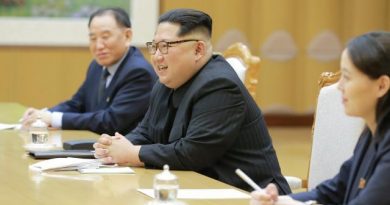Despite Foreign Threats of Regime Change, Domestic Unrest Remains Iran’s Greatest Adversity
By Felipe Bueno
Editor-in-Chief
The Trump administration has no qualms expressing its feelings towards Iran’s leadership. From threatening “consequences the likes of which few throughout history have ever suffered,” to claiming that a regime change will occur in the near future, to blaming Iran for the Middle East’s problems, the U.S. is remarkably candid.
U.S. policy towards Tehran is by no means an anomaly. Iran is currently entangled in a proxy war with Saudi Arabia, with both sides slaughtering each other’s troops in Yemen, Syria, Bahrain, and Saudi Arabia’s Eastern Shiite Province. Closer to home, Saudi Arabia funds an Iranian separatist group, the century-old Mujahedin-e Khalq (MEK), bent on creating discord inside of Iran.
With a new round of sanctions right around the corner, many key U.S. allies have also turned their back on the Islamic Republic.
Japan, South Korea, Sri Lanka, and European countries all plan to reduce imports from Iran amidst sanctions targeting the country’s oil industry. Bpifrance, a French state-owned bank, recently backpedaled its initiative to help French companies that wished to trade with Iran; a move that contradicts France’s desire to uphold the requirements set out in the Nuclear Deal.
Amidst these external pressures, Iran turned to Russia and China, who also declined to assist. Russia is more than happy to fill Iran’s gap in the oil market, meanwhile China is equally preoccupied with its own series of U.S. sanctions.
Iran’s biggest threat however, burns inside its very own boarders. Iran’s oil industry, despite facing sanctions from abroad, is plagued internally by unrest in the country’s oil-producing province. Khuzestan, located on the country’s southwest border with Iraq, holds 70 percent of Tehran’s oil reserves.
Despite possessing the country’s largest revenue source, the region is poor and neglected. Khuzestan is home to Iran’s Muslim-minority, a perfect breeding ground for ethnic tensions. Iranian Arabs say they are kept out of local legislature while the country’s Persian majority reaps the benefit of its oil exports.
The economic problems Iran faces disproportionately hurt Khuzestan. The region’s unemployment rate is 14.5 percent, higher than the national rate of 11.8 percent. Water and electricity shortages, along with a severe drought, have only compounded Muslim plight.
Subjecting an ethnic minority to poverty while denying them the benefits of the region’s economic contribution has led to the increasing popularity of the MEK. Recently, gunmen associated with the MEK opened fire at a military parade in the capital of the Khuzestan province. The MEK gunmen killed at least 24 people, including a 4-year-old boy, and wounded nearly 70.
While Iran has attempted to divert the blame to the United States and Saudi Arabia, citing the former’s support of the MEK, unrest throughout the country, caused by poor management of the banking system and the depreciation of the country’s national currency, continues to spread.
Following the closure of numerous financial institutions in recent years, most notably the Caspian Finance and Credit Institution, Iranian citizens protested the government. The protests were directed at President Hassan Rouhani, who promised to revitalize the economy when he sought reelection in 2017, and Ayatollah Ali Khamenei, the country’s supreme leader.
Political corruption facilitated the failure of these financial institutions, which allowed well-connected elites to gamble with bank deposits and afforded them impunity while doing so. In a statement that only galvanized protesters further, the government deflected blame by claiming that victims should have been more careful with their money.
The rial’s depreciation only led to further unrest. Having lost 35 percent of its value earlier this year, the rial plummeted again earlier this month. Every time the rial faces severe depreciation Iranians default to the world’s reserve currency: the U.S. dollar.
When Rouhani took office in 2013, the rial’s going rate was 36,000 rials to the dollar. When the currency plummeted in early September, any currency exchange shops that were still willing to trade offered 150,000 rials to the dollar.
Households everywhere felt the immediate impact of this depreciation as Iran faced a serious diaper shortage. Around 70 percent of the material for disposal diapers are imported. As the rial loses value, diapers becomes much more expensive to households.
While the government has been able to unify the country using Persian nationalism in the past, the current unrest is unlike anything it has faced before. The outside pressures faced by Iran might prove too much to handle if domestic dissident groups continue to gain momentum.


